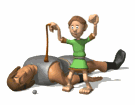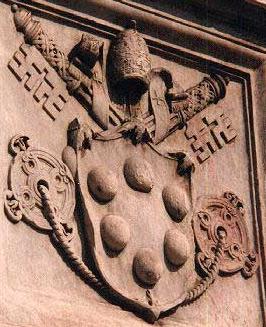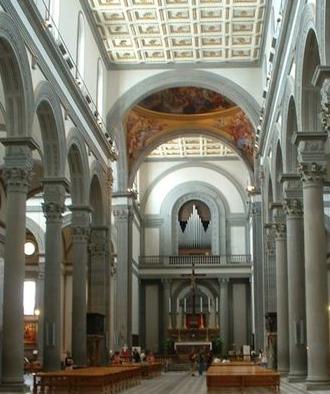
Candida Martinelli's Italophile Site

Main
Page This family-friendly site celebrates Italian culture for the enjoyment of children and
adults. Site-Overview
The family's history parallels
Italy's history. I've divided it into sections listed in the left
column. This concise history is a helpful guide to read before
traveling to Florence and the Vatican.
The
de' Medici family of Mugello, Tuscany, a small town north of Florence,
built a commercial empire, then they used cunning and at times cut-throat
tactics to gain political power over several centuries (1380s - 1700s),
spanning the Late-Middle-Ages, the Renaissance, and the
Age-of-Discovery, as: The de' Medici
became the richest family in Europe.
The family coat-of-arms decorates much of Florence because they
financed building and renovation projects throughout the Italian
Renaissance, decorating the buildings by the most illustrious Italian artists.
An early de' Medici, Cosimo the Elder, said that
Florentine politics was iffy, but buildings last. He was right
about that and many more things.
If you're interested in coats-of-arms, click on the image below to go to
a
heraldry site with all the Medici coat-of-arms from the beginning of
the dynasty to its
end.
The name de' Medici means 'of the
doctors', suggesting the early family members were medical men.
This could mean they were barbers who made plant and herbal potions, or
doctors who visited the sick, drew blood with leeches, made pills, teas
or drops from herbal and plant extracts.
Interestingly, the de' Medici family members, from beginning to end,
showed more than usual interest in botany, the science behind herbal and
plant potions. Their gardens were treasure troves of medicinal
herbs.
Their family name and especial interest in plants could
explain the popular association of poisons with the de' Medici family,
which was further fueled by the sudden deaths of many of their enemies and less-liked relations. Honore de Balzac, the French writer, described the House of the
Medici as being the sovereign house with the greatest contempt for
legitimacy anywhere in the world. "To whichever the crown goes, he
is true, the legitimate sovereign." Here's how Balzac described Italy
and the era of the Italian Renaissance: "At this epoch Venice had the commerce of the world; Rome had its
moral government; Italy still reigned supreme through the poets, the
generals, the statesmen born to her. "At no period of the world's
history, in any land, was there ever seen so remarkable, so abundant a
collection of men of genius. There were so many, in fact, that
even
the lesser princes were superior men. "Italy was crammed with
talent, enterprise, knowledge, science, poesy, wealth, and gallantry,
all the while torn by intestinal warfare and overrun with conquerors
struggling for possession of her finest provinces. "When men are so
strong, they do not fear to admit their weaknesses. Hence, no
doubt, this golden age for bastards. We must, moreover, do the
illegitimate
children of the house of the Medici the justice to say that they were
ardently devoted to the glory, power, and increase of wealth of that
famous family." It is now believed that a special,
secret crypt found beneath the Basilica di San Lorenzo was created
specifically for the illegitimate de' Medici children. Cosimo the
Elder had at least one illegitimate child, Carlo, who lived a long life
linked to the family and the family business, and it was Cosimo the
Elder who planned with the architect what was built under the church,
including his own grave. That the de' Medici, a powerful and wealthy family,
had so many openly recognized illegitimate children is no
surprise. The Renaissance was a time of: That meant for the de' Medici men that: Balzac notes that it wasn't until the late 1500s that there was an
orderly, legitimate and peaceful succession of power from one de' Medici
Duke of Tuscany to the next.
Also, I believe not coincidentally,
that's when the de' Medici heirs begin their moral and intellectual
decline, the line becoming extinct in 1737 with the long-wished-for
passing of the last, disgraceful, de' Medici Grand Duke of Tuscany,
leaving no heirs. The marriages to cousins did not help their
health nor intelligence, so the earlier competition for the title among
all the heirs, legitimate or not, made sure the strongest, worthiest
contender won, and helped the House of Medici survive as long as it did. To the next section:

The
de' Medici Dynasty
![]()

The de' Medici Dynasty and Italian History
The Late-Middle-Ages, Early Renaissance, Giovanni: The Founder
The Early Renaissance, Cosimo and Lorenzo: The Elders
The High Renaissance, Piero and his son, Lorenzo the Magnificent
Florentine Independence and the End of the
Florentine Renaissance, Piero II and Lorenzo II in Exile
The Roman Renaissance, Cardinal Giulio de' Medici and Pope Leo X
(Giovanni de' Medici)
The End of Florentine Independence, Pope Clement VII (Giulio de' Medici), Alessandro, and
Caterina de' Medici
The Late Renaissance, The Grand Duke and Duchess of Tuscany: Cosimo de' Medici
and Eleonora di Toledo
The Age of Discovery, Francesco and Ferdinando: Two Very Different Brothers
The Age of Reason and The Enlightenment, The Decline of de' Medici Reason and Enlightened
Governance
The de' Medici Dynasty and Italian History


The Late-Middle-Ages, Early Renaissance, Giovanni: The Founder